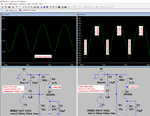matrixofdynamism
Advanced Member level 2
I have an electret microphone that I connect to +ve supply using a 10k resistor (yes the value is arbitrary). The microphone itself has 2k resistance measured using an ohm meter. The voltage across the microphone is to be connected to a common emitter amplifier using a 1nF capacitor (again an arbitrary value) to filter out DC and obtain voltage gain for the AC signal.
Now the question; I have a few hundred mV of signal that develops across the microphone passes through the capacitor and want to amplify this before it can be input to an ADC. When we using an OpAmp, the calculations for gain are quite simple since the signal is thought of as a voltage as no current enters the (ideal) OpAmp anyway. But for the CE amplifier we talk of base current, look at the beta value and then choose a value of collector resistance to convert that to voltage.
I do not know the base current, I only know the range of voltages that shall be applied across the base, how then do I calculate what value resistor to use? Do you have any advice on how the values for the already arbitrary resistor and capacitor should be chosen?
Now the question; I have a few hundred mV of signal that develops across the microphone passes through the capacitor and want to amplify this before it can be input to an ADC. When we using an OpAmp, the calculations for gain are quite simple since the signal is thought of as a voltage as no current enters the (ideal) OpAmp anyway. But for the CE amplifier we talk of base current, look at the beta value and then choose a value of collector resistance to convert that to voltage.
I do not know the base current, I only know the range of voltages that shall be applied across the base, how then do I calculate what value resistor to use? Do you have any advice on how the values for the already arbitrary resistor and capacitor should be chosen?
